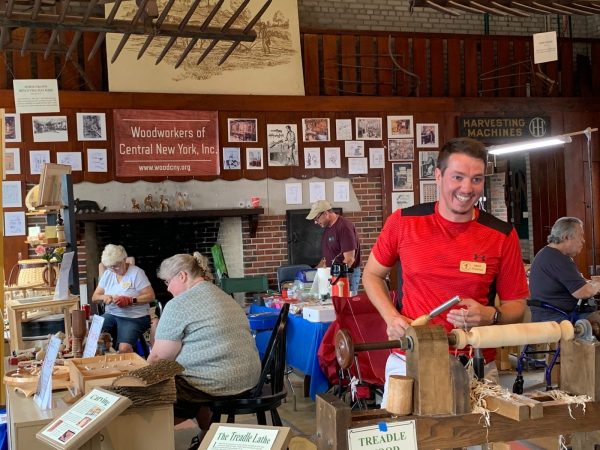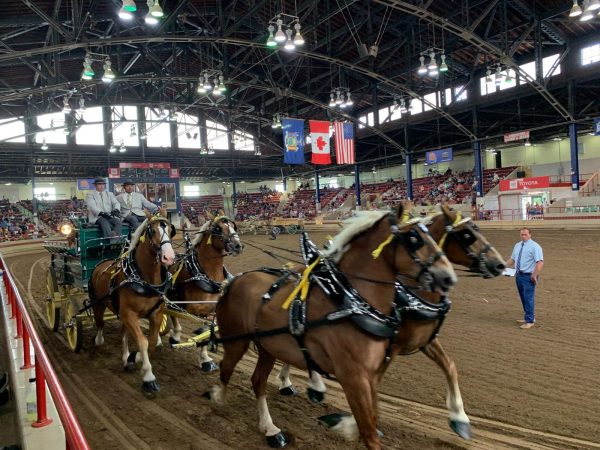New York State’s annual state fair was held this year from Aug. 23 to Sept. 4. People from across New York State and beyond came together to experience 14-days of delicious foods, eye-opening exhibits, captivating entertainment and loads of fun.
The festivities were held at the New York State Fairgrounds, which boasts 50 buildings of various sizes, and near 380 thousand square feet of event space that can accommodate upwards of two million people.
This year Vision Times staff were in attendance to scope out all the fun and engage in preserving New York State’s traditions.

Traditional log cabin erected on site
One popular exhibit displayed at the agricultural museum on site was a log cabin, originally constructed in 1876 that was disassembled at its original location and erected at the state fair.
The cabin was originally constructed by a farm laborer in Schoharie County, just west of Albany, who lived in the small cabin with his wife and five sons.
Success
You are now signed up for our newsletter
Success
Check your email to complete sign up
The exhibits host, Susan, said the cabin consists of a single room and a loft where the entire family lived a difficult but “rewarding” life.
“They all lived within this one room … and they did have a loft, so as the boys got older they could sleep in the loft but otherwise they would be sleeping downstairs on the trundle bed, maybe with their parents in the one bed that was here,” she said.
“I am sure as they got older they would have helped their father with chores and working on the farm. And the mother did all the cooking over the stove, or the fireplace stove and they had a very, I’m sure, difficult life but also a very rewarding” life she said adding that, “They were here for ten years before they left and then the cabin was sold to someone else.”

Treadle lathes
On display and available for fair goers to interact with was a traditional Treadle lathe. Treadle lathes have been around for some 500 years and the first known drawing of one was by Leonardo da Vinci (1452-1519).
The lathe was used to construct a variety of things including the lathe itself. Examples of items made on the lathe include tool handles, table legs, chair parts, rolling pins, plates, bowls, stools, wagon parts and even toys.
Craftsmen sometimes travelled with the lathe in a wagon going to remote villages and farms to make needed wooden parts for a variety of things around the home. In the 1900s when electricity became available these lathes were converted to electrical power. Prior to the advent of electricity they would be powered by humans, animals or water wheels.
The lathe onsite at this year’s festivities was a replica fabricated several years ago to use for demonstrations and is continually modified to allow for easier human powering.
Food, food and more food
This year the state fair boasted over a hundred different food vendors, hailing from communities across New York State and beyond.
Festival goers could partake in everything from pizza, served up by Brewerton, New York’s Twin Trees Pizza, to Greek cuisine provided by Liverpool, New York’s Stephen’s Greek Cuisine.
To cool down, festival attendees could enjoy a tall glass of lemonade provided by Omani’s Lemonade Heaven, or they could sit down and enjoy a beverage from the Syracuse Suds Factory.
Of course, sweets like caramel apples, ice cream and candy flowed freely.
For the more adventurous of fair goers Pickle Barrel Sirloin Tips and Elephant Ears were available to try and for the less adventurous, traditional fairs like baked potatoes, fried fish, hot dogs and BBQ were in plentiful supply.
The festivities attracted food vendors from across the United States with several vendors making the trip north from Florida, including the Butcher Boys, Wild Bill’s Curly Fries, Peachey’s Baking Company and Fried Specialties.
Vendors from Texas also made an appearance including Cinder BBQ and Russell’s Concessions +, and Moose Joose Slush set up shop for the fair coming from as far away as Mooresville, North Carolina.

Complete Indian Fair
The Ancient Nations of the Iroquois Confederacy enthralled spectators with demonstrations of their culture.
“From our farms, gardens and woodlands on our eight reservations, we bring our exhibits to compete each year against each other, as our Indian Village is our combined annual Fair, held at the State Fairgrounds in preference to holding several separate Fairs at our reservations,” reads a statement by the Confederacy.
The Cayugas, Onondagas, Oneidas, Senecas, Mohawks and Tuscaroras nations were all in attendance.
Under the direction of Martin Jimerson of the Cattaraugus Senecas (Erie Co) traditional dancers from Tonawanda Senecas (Genesee Co.), Allegany Senecas (Cattaraugus Co.), Cayugas, Onondagas (near Syracuse), Tuscaroras (Niagara Co.) Oneidas and Mohawks (St, Regis) near Massena performed on Turtle Mound.
“In the dawn of human occupation, there lived here the-AM-eo-lithnic Indians, or Early dawn stone people to be followed by three strata of Algonquin Indians, the group who welcomed and fed the Pilgrims at Plymouth Rock and occupied Long Island and both sides of the Hudson River when the Half Moon came,” reads a statement by the Confederacy.
Traditional exhibits of ancient handicraft were on display, made by workers from all eight reservations including cabin curtains made from animal pelts, headdresses and cloaks made of feathers and needles, hair combs and beads made from animal bones.

Friendly competition
Horse pulling is a draft horse competition where horses in harness, usually one or two animals, pull a stone-boat or weighted sled and the winner is the team or animal that can pull the most weight for a short distance.
Belgian breeds of horses are the breed most frequently seen, however other draft breeds are also used. There are different weight classes and strict rules to avoid animal cruelty.
This year, in the Heavyweight Championship Pull, Casey Harriman took first place followed by Doug Smith in second and Jerry Voorhis in third.
For the lightweight category, Billy Howard secured a first place win and Geertman Root took both second and third place followed by Doug Smith in fourth and Wayne Dodge in fifth.
Winners enjoyed cash prizes ranging in size from $80 to $300.
Practitioners of Falun Gong, a Chinese spiritual practice, also manned a booth at the New York State Fair.
Falun Dafa, also called Falun Gong, is a meditative discipline in the Buddhist tradition. It combines meditation and gentle exercises with a moral philosophy centered on the tenets of truthfulness, compassion, and tolerance.
Wu Xiaoyan, the booth’s coordinator, told The Epoch Times that a total of 18 boxes of materials were distributed over 13 days to fair goers and more than 2,000 people signed a petition to end the Chinese Communist Party (CCP).
Thousands of small lotus flowers with the words “Falun Dafa is good, Truthfulness-Compassion-Forbearance is good” written on them were distributed.
For many fair goers this was the first time they had a chance to learn about Falun Dafa and Wu Xiaoyan told The Epoch Times that thousands of fair goers were attracted to the booth, curious about the practice derived from ancient Chinese culture.















